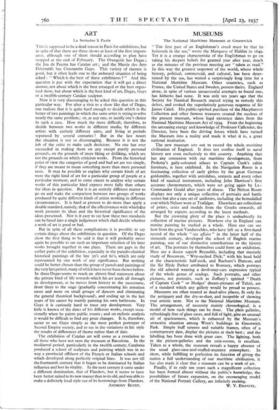MUSEUMS
The National Maritime Museum at Greenwich
" THE first part of an Englishman's creed must be that he believeth in the sea," wrote the Marquess of Halifax in 1649. Yet it is a strange characteristic of the Englislunan to go on taking his deepest beliefs for granted year after year, much as the minutes of the previous meeting are " taken as read." In this way the greatest seapower of the world, whose whole history, political, commercial, and cultural, has been deter- mined by the sea, has waited a surprisingly long time for a National Maritime Museum. Other countries, such as France, the United States and Sweden, possess theirs. England alone, in spite of various unsuccessful attempts to found one, has hitherto had none. It was only ten years ago that the Society for Nautical Research started trying to remedy this defect, and evoked the superlatively generous response of Sir James Caird. His public-spirited purchase of the Macpherson Collection and other famous treasures created the nucleus of the present museum, whose legal existence dates from the
National Maritime Museum Act of 1934. From the beginning the unceasing energy and knowledge of Professor Callender, the Director, have been the driving forces which have turned the Museum into a reality and made it what it is, a great national institution.
The new museum sets out to record the whole -maritime civilisation of England. It does not confine itself to naval history nor even exclusively to this country. Anything that has any connexion with our maritime development, from Ptolemy's gaily-coloured atlases to Captain Cook's cabin furniture, is here exhibited. In the Navigation Room is a fascinating collection of early globes by the great German goldsmiths, together with astrolabes, sextants and every other kind of nautical instrument, including John Harrison's first accurate chronometers, which were set going again by Lt.- Commander Gould after years of disuse. The Nelson Room displays not only a unique collection of portraits and battle scenes but also a rare set of uniforms, including the bemedalled coat which Nelson wore at Trafalgar. Elsewhere are collections of prints, coins and medals from the Greeks onwards, all arranged by experts according to the latest methods.
But the crowning glory of the place is undoubtedly its
collection of marine pictures. Nowhere else in England can marine painting be studied as a whole. Here one can see how from the great Vanderveldes, who have left us a first-hand record of the whole " sea affaire " in the latter half of the sixteenth century, developed the school of English marine painting, one of our distinctive contributions to the history of art. The portraits by themselves could form an exhibition. Here are a dozen superb Reynolds, including that masterly study of Boscawen, " Wry-necked Dick," with his head held at the characteristic half-cock, and Raeburn's Duncan, and the Sir Hyde Parker attributed to Romney, which portrays the old admiral wearing a devil-may-care expression typical of the whole genus of seadogs. Such portraits, and other pictures, not portraits, such as Zoffany's spirited " Death of Captain Cook " or Hodges' dream-pictures of Tahiti, are of a standard which any gallery would be proud to possess.
Museums are often treated as dead-alive places, fit only for
the antiquary and the dry-as-dust, and incapable of showing true artistic taste. Not so the National Maritime Museum. The arrangement, of necessity mainly chronological, is a model of how such things can be done. The plain galleries, refreshingly free of glass cases, and full of light, give an unusual air of spaciousness, which is enhanced by the Museum's attractive situation among Wren's buildings in Greenwich Park. Simple buff screens and suitable frames, often of a contemporary date, display the pictures at their best ; and the labelling has been done with great care. The lighting, both in the picture-galleries and the coin-rooms, is excellent. Taken as a whole, the museum reveals a happy absence of the usual glass-case-and-stuffed-mummy atmosphere. In short, while fulfilling to perfection its function of giving the nation a full understanding of our maritime civilisation, it has also made it clear that a museum can be a work of art.
Finally, if in only ten years such a magnificent collection has been formed almost without the public's knowledge, the possibilities of future expansion, on the encouraging model of the National Portrait Gallery, are infinitely exciting.
W. V. EMANUEL.










































 Previous page
Previous page